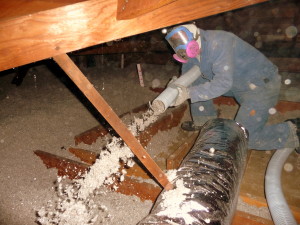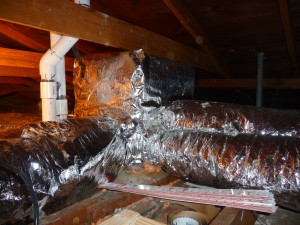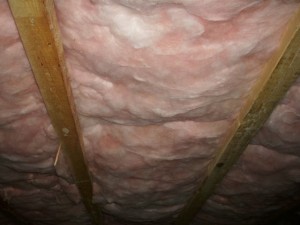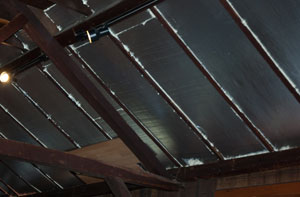 If your house was not specifically built for energy efficiency, adding insulation can lower your energy costs and make your home more comfortable. First off, you need to know what type of insulation you have already, and where it is. Also, you will want to know how well your house is air sealed. The easiest way to get all this information is to hire a qualified home energy auditor to perform a whole-house energy assessment.
If your house was not specifically built for energy efficiency, adding insulation can lower your energy costs and make your home more comfortable. First off, you need to know what type of insulation you have already, and where it is. Also, you will want to know how well your house is air sealed. The easiest way to get all this information is to hire a qualified home energy auditor to perform a whole-house energy assessment.
 Your energy auditor will also be able to inspect your insulation, determining what type you have, where it is, and whether it was installed properly and/or has degraded significantly. After air sealing, attic insulation is often where you can get the best “bang for your buck” only second to sealing up Duct Leakage. Duct Insulation can also be highly effective in decreasing energy loss and improving air quality and comfort inside your home. Your auditor will help you choose your most cost-effective options. Some of the more common types of insulation are listed below.
Your energy auditor will also be able to inspect your insulation, determining what type you have, where it is, and whether it was installed properly and/or has degraded significantly. After air sealing, attic insulation is often where you can get the best “bang for your buck” only second to sealing up Duct Leakage. Duct Insulation can also be highly effective in decreasing energy loss and improving air quality and comfort inside your home. Your auditor will help you choose your most cost-effective options. Some of the more common types of insulation are listed below.
 This is very effective for walls and accessible attics. It is blown in loose and can get around obstructions and fill in gaps in existing insulation. It is formaldehyde free and made from recycled paper and fabrics treated with fire retardant. The chemicals are safe for humans and may actually repel pests and mold. Cellulose insulation is also highly resistant to temperature fluctuations and has smaller more numerous air spaces, giving it a higher R-value (thermal resistance) than fiberglass. However, cellulose will absorb water, decreasing its R-value, so it should be installed in areas with little to no moisture exposure.
This is very effective for walls and accessible attics. It is blown in loose and can get around obstructions and fill in gaps in existing insulation. It is formaldehyde free and made from recycled paper and fabrics treated with fire retardant. The chemicals are safe for humans and may actually repel pests and mold. Cellulose insulation is also highly resistant to temperature fluctuations and has smaller more numerous air spaces, giving it a higher R-value (thermal resistance) than fiberglass. However, cellulose will absorb water, decreasing its R-value, so it should be installed in areas with little to no moisture exposure.
 Like cellulose blown-in, this is effective for filling gaps or irregular spaces, although it does not settle in quite as well, giving it a lower R-value. However, it has the advantage of being non-combustible, and non-absorbent. It also uses recycled glass materials and sand, both of which are renewable resources. The main concern with fiberglass is that caution must be taken to avoid inhalation of airborne particles, both during installation, and if the fiberglass is ever exposed and/or disturbed in the future.
Like cellulose blown-in, this is effective for filling gaps or irregular spaces, although it does not settle in quite as well, giving it a lower R-value. However, it has the advantage of being non-combustible, and non-absorbent. It also uses recycled glass materials and sand, both of which are renewable resources. The main concern with fiberglass is that caution must be taken to avoid inhalation of airborne particles, both during installation, and if the fiberglass is ever exposed and/or disturbed in the future.
 These are “blankets” or rolls of fiberglass that are fitted between studs or beams. They are relatively inexpensive and can be effective in areas with regularly shaped sections that are free of obstacles. Therefore, these are generally recommended for floors, and sometimes in attic floors or newly constructed walls. Proper installation is huge with these, as they must be fitted snugly, but not compressed, which will decrease their R-value. Precise measurement in cutting and fitting is necessary. There are an enormous number of cases where they have either been installed very poorly and/or have degraded over time. In attics a lot of care must be taken to Install them around recessed lights and to make absolutely sure the batt is in contact with the attic floor. It is for these reasons that Blown In Cellulose is recommended instead for walls and attics.
These are “blankets” or rolls of fiberglass that are fitted between studs or beams. They are relatively inexpensive and can be effective in areas with regularly shaped sections that are free of obstacles. Therefore, these are generally recommended for floors, and sometimes in attic floors or newly constructed walls. Proper installation is huge with these, as they must be fitted snugly, but not compressed, which will decrease their R-value. Precise measurement in cutting and fitting is necessary. There are an enormous number of cases where they have either been installed very poorly and/or have degraded over time. In attics a lot of care must be taken to Install them around recessed lights and to make absolutely sure the batt is in contact with the attic floor. It is for these reasons that Blown In Cellulose is recommended instead for walls and attics.
 This stuff is effective in tight spaces. It can provide good insulation with low thickness. However, it can be fairly expensive to install, so it is generally recommended for situations where it is the only option. The most common examples are buildings with inaccessible flat roofs or with cathedral ceilings. Some builders will attempt to use blown-in cellulose in these situations, which often ends up being a disaster due to vapor condensation and moisture damage if a 2” gap is not left between insulation and the roofing material. Exterior applications of foam board require a weather-proof facing, and interior applications require a fire-proof covering.
This stuff is effective in tight spaces. It can provide good insulation with low thickness. However, it can be fairly expensive to install, so it is generally recommended for situations where it is the only option. The most common examples are buildings with inaccessible flat roofs or with cathedral ceilings. Some builders will attempt to use blown-in cellulose in these situations, which often ends up being a disaster due to vapor condensation and moisture damage if a 2” gap is not left between insulation and the roofing material. Exterior applications of foam board require a weather-proof facing, and interior applications require a fire-proof covering.
I’m searching the web with regards to home insulations and I’m very impressed with this very informative blog It is important to install insulation at home because it minimize the proper temperature at home.. Thanks for sharing!
I didn’t realize that there were so many different insulation types. I have only ever seen the fiberglass batts in homes before. However, it looks like the fiberglass blow-in would be super nice for filling in spaces, like you said.